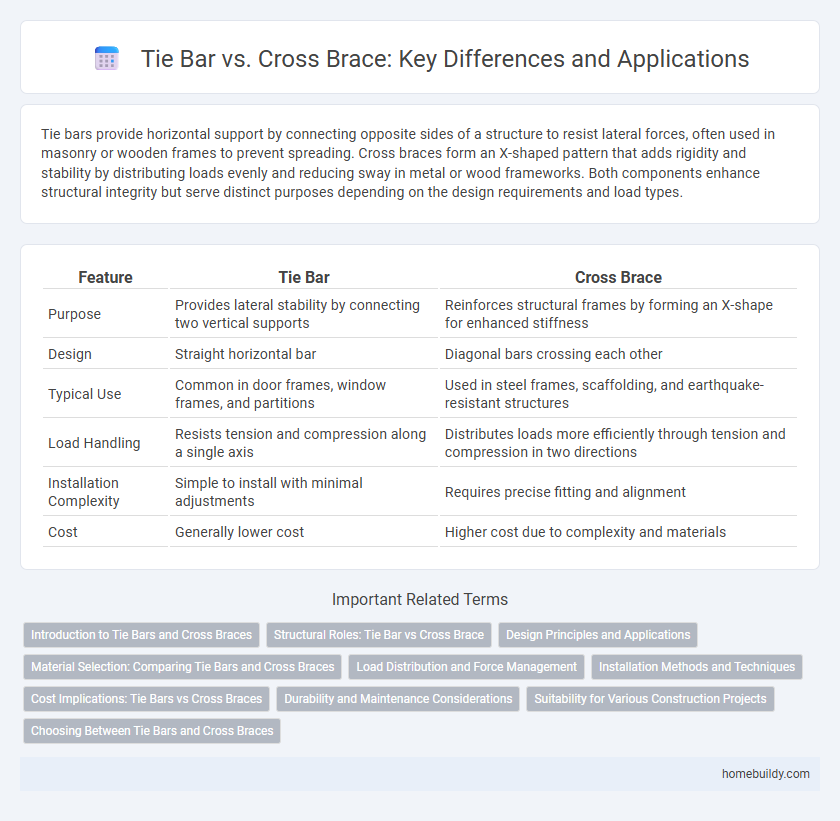Tie bars provide horizontal support by connecting opposite sides of a structure to resist lateral forces, often used in masonry or wooden frames to prevent spreading. Cross braces form an X-shaped pattern that adds rigidity and stability by distributing loads evenly and reducing sway in metal or wood frameworks. Both components enhance structural integrity but serve distinct purposes depending on the design requirements and load types.
Table of Comparison
| Feature | Tie Bar | Cross Brace |
|---|---|---|
| Purpose | Provides lateral stability by connecting two vertical supports | Reinforces structural frames by forming an X-shape for enhanced stiffness |
| Design | Straight horizontal bar | Diagonal bars crossing each other |
| Typical Use | Common in door frames, window frames, and partitions | Used in steel frames, scaffolding, and earthquake-resistant structures |
| Load Handling | Resists tension and compression along a single axis | Distributes loads more efficiently through tension and compression in two directions |
| Installation Complexity | Simple to install with minimal adjustments | Requires precise fitting and alignment |
| Cost | Generally lower cost | Higher cost due to complexity and materials |
Introduction to Tie Bars and Cross Braces
Tie bars provide lateral stability by connecting structural elements in a straight line to resist tension forces, commonly used in concrete construction and masonry walls. Cross braces form an X-shaped pattern between beams or columns, enhancing rigidity and resistance to both tension and compression forces in steel frameworks and seismic designs. Understanding the distinct load distribution and installation methods of tie bars versus cross braces is crucial for selecting the appropriate reinforcement system in building projects.
Structural Roles: Tie Bar vs Cross Brace
Tie bars primarily resist tensile forces, providing lateral stability by connecting structural elements to prevent separation under stress. Cross braces enhance rigidity by forming diagonal supports that distribute both compressive and tensile loads, improving overall frame stiffness. Understanding the distinct load-bearing and stabilizing functions of tie bars versus cross braces is essential for optimizing structural integrity.
Design Principles and Applications
Tie bars primarily resist tensile forces in structural frameworks, ensuring lateral stability by preventing components from pulling apart, while cross braces handle both tensile and compressive loads, stabilizing structures against buckling and lateral displacement. Tie bars are commonly used in masonry walls and concrete frames for straightforward tension reinforcement, whereas cross braces are preferred in steel frames and seismic designs requiring multidirectional load resistance. The selection between tie bars and cross braces depends on specific design principles such as load types, structural material, and application demands for rigidity and flexibility.
Material Selection: Comparing Tie Bars and Cross Braces
Tie bars are commonly made from high-strength steel or aluminum alloys, offering excellent tensile strength and durability for structural reinforcement. Cross braces typically utilize steel for superior compression resistance and lateral stability in frameworks, often incorporating thicker gauges to withstand shear forces. Material selection between tie bars and cross braces depends on load requirements, environmental exposure, and flexibility needed in the structural design.
Load Distribution and Force Management
Tie bars provide linear support by distributing tensile forces along a single axis, effectively managing load in structures subjected to unidirectional stress. Cross braces offer multi-directional stability by forming triangular frameworks that dissipate forces through both tension and compression, enhancing overall rigidity. The choice between tie bars and cross braces depends on the specific load distribution requirements and the complexity of force management in the structural design.
Installation Methods and Techniques
Tie bars are installed using bolting or welding techniques, often requiring precise alignment to ensure structural stability, while cross braces typically involve diagonal placement secured with gusset plates for load distribution. The installation of tie bars demands accurate tensioning to prevent structural deformation, whereas cross braces rely on fixed connections for lateral support. Both methods require specialized tools, but tie bars allow for easier adjustment post-installation compared to the more rigid cross brace setup.
Cost Implications: Tie Bars vs Cross Braces
Tie bars generally offer a more cost-effective solution compared to cross braces due to simpler materials and faster installation requirements. Cross braces incur higher labor costs and increased material expenses because of their more complex design and structural components. Choosing tie bars can significantly reduce overall project costs while maintaining adequate stability in many applications.
Durability and Maintenance Considerations
Tie bars offer superior durability compared to cross braces, as they are typically made from high-strength steel designed to withstand significant tension and compression forces. Maintenance of tie bars is minimal due to their simple design and fewer connection points, reducing the likelihood of wear and corrosion. Cross braces, while effective, require more frequent inspections and upkeep because their multiple joints and connections are prone to loosening and rust over time.
Suitability for Various Construction Projects
Tie bars provide flexible tension support ideal for stabilizing concrete forms in residential and small-scale commercial projects due to their ease of installation and cost-effectiveness. Cross braces offer superior rigidity and lateral stability, making them more suitable for large-scale or high-rise construction where structural integrity under dynamic loads is critical. Selecting between tie bars and cross braces depends on project size, load requirements, and desired durability in framing systems.
Choosing Between Tie Bars and Cross Braces
Tie bars provide linear tension support by connecting parallel structural elements, making them ideal for resisting axial loads and maintaining alignment. Cross braces, typically arranged in an X-pattern, offer enhanced lateral stability by distributing forces in multiple directions, which is critical for resisting shear and sway. Selecting between tie bars and cross braces depends on load types, structural geometry, and specific reinforcement requirements for optimal framing performance.
Tie bar vs Cross brace Infographic

 homebuildy.com
homebuildy.com